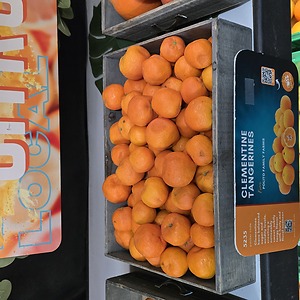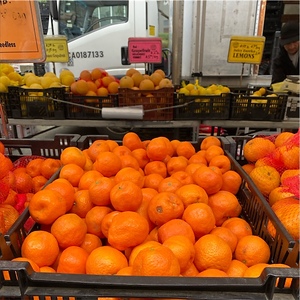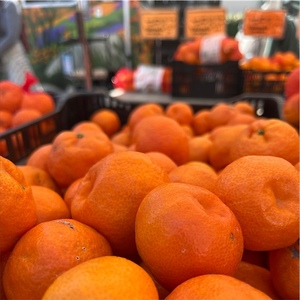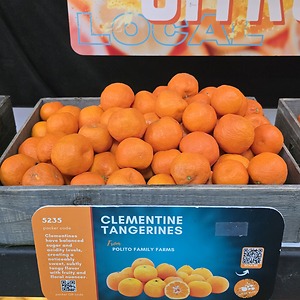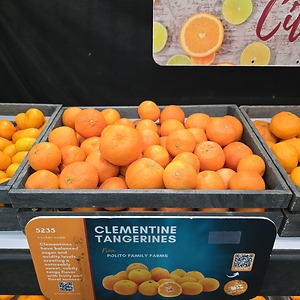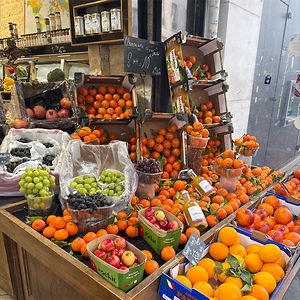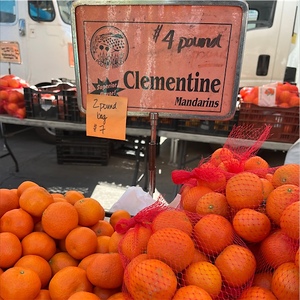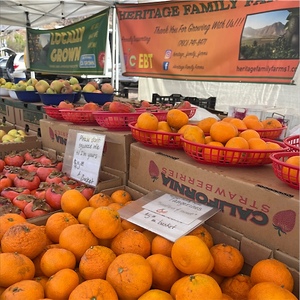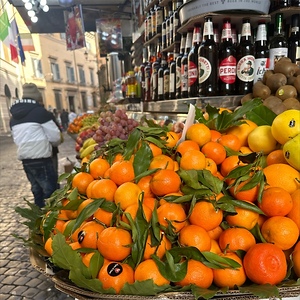

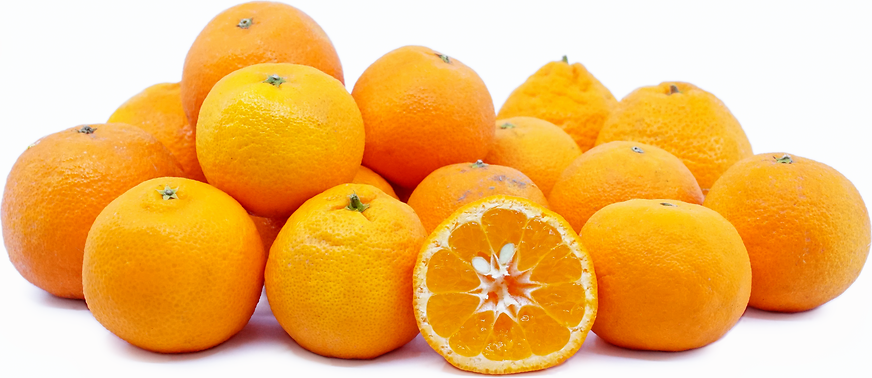
Clementine Tangerines
Estimated Inventory, 30 lbs : 0
Description/Taste
Clementines are small to medium fruits, averaging 5 to 10 centimeters in diameter, and vary in shape from round, sometimes slightly flattened, to oblate. The skin is thin, bright orange to orange-red, and semi-smooth, ranging from glossy, leathery, to faintly textured due to prominent oil glands. The skin is also easily peeled from the flesh, emitting an aromatic and bright, floral scent when torn, revealing a thin layer of white pith. The pith does not cling to the flesh, and the orange flesh is divided into 7 to 14 segments by thin membranes. The flesh is semi-aqueous, tender, and soft, either being found seedless or containing a few cream-colored seeds. Clementines have balanced sugar and acidity levels, creating a noticeably sweet, subtly tangy flavor with fruity and floral nuances.
Seasons/Availability
Clementines are available year-round, with a peak season in the late fall through mid-winter.
Current Facts
Clementines, botanically a part of the Citrus genus, are a hybrid mandarin variety belonging to the Rutaceae family. The name Clementine is a general descriptor used to encompass over fifteen closely related hybrid varieties, displaying similar characteristics, and the fragrant fruits are some of the smallest orange cultivars available in commercial markets. Clementines are popular fruits worldwide, favored for their petite size, easy-to-peel skin, and sweet flavor. The fruits are primarily consumed fresh, toted as a favorite children’s snack or travel food, and have become a dominant sector of the global citrus market, being grown worldwide for year-round availability.
Nutritional Value
Clementines are an excellent source of vitamin C to strengthen the immune system and provide beta-carotene, the colored pigment within the flesh that is converted into vitamin A in the body. The fruits are also are a source of fiber to regulate the digestive tract, antioxidants to reduce inflammation, potassium to balance fluid levels, and folate to produce red blood cells for oxygen transport.
Applications
Clementines are a sweet, easy-to-peel fruit favored for fresh applications and as a flavoring in cooked preparations. The fruits can be segmented and consumed straight out-of-hand, tossed into salads, or they can be mixed into grain bowls, fruit salads, cereal, and granola. They can also be used as a fresh topping over ice cream, tarts, and cakes, dipped into melted chocolate, or blended into smoothies and frozen desserts. Beyond fresh applications, Clementines can be used to flavor glazes, sauces, and marinades, zested for desserts and bread or simmered into jams and marmalade. Clementines pair well with nuts such as almonds, walnuts, and pistachios, sunflower seeds, olives, honey, cheeses, including feta, goat, and brie, herbs such as mint, cilantro, and parsley, lemon, seafood, and meats such as poultry, pork, and beef. Whole, unopened Clementines have a shorter shelf life compared to other orange varieties. The fruits will keep for 2 to 7 days when stored at room temperature away from direct sunlight, but they will quickly begin to lose moisture with each day. The fruits can also be stored in a mesh bag or a drawer of the refrigerator for 1 to 2 weeks.
Ethnic/Cultural Info
In the United States, Clementines are often marketed under memorable commercial names to attract consumers. Mandarin oranges, including Clementines, have become one of the fastest-growing sectors of the citrus market, and consumers favor the fruits for their easy-to-peel skin, small size, sweet flavor, and relatively seedless nature. Throughout the year, bundles of Clementines are wrapped in colorful marketing and are sold under names such as Cuties, Wonderful® Halos®, Darling Clementines®, and Sunkist Delites®. These general names were created to appeal to a broader range of consumers and were also a targeted marketing tool to promote the fruits as nutritious snacks. Clementines sold under these commercial names are available between November through January. In addition to Clementines, w murcott mandarins and tango mandarins are also sold interchangeably with Clementines under the commercial names to provide easy-to-peel fruits for an extended season. Some companies also grow Clementines worldwide to develop a steady, year-round supply.
Geography/History
Clementines have a murky history as experts heavily debate the variety’s origins. The most well-known theory retells the legend of a monk cultivating citrus at an orphanage in Misserghin, a small village near Oran, Algeria, in Northern Africa. Father Clement Rodier tended the garden at Péres du Saint-Esprit and one day discovered an accidental cross between a sweet orange and a willowleaf mandarin. Rodier presented the variety to the Horticultural Society of Algiers, and the variety was officially named Clementine, in honor of the monk, in 1902. Many modern-day scientists now refute this theory and point the variety back to East Asia, where mandarins were originally discovered. Many experts believe the cultivar is closely related, if not identical, to the canton mandarin. Regardless of their origins, Clementines were planted throughout the Mediterranean and were introduced to Florida in 1909. The variety was brought to the Citrus Research Center in Riverside, California, by H.S. Fawcett, and in 1914, the fruits were released to commercial growers. Today Clementines are grown worldwide and are commercially produced in California, Texas, North Africa, China, Spain, Uruguay, Peru, and Chile. The small fruits are widely available through local growers, farmer’s markets, supermarkets, and specialty grocers.
Recipe Ideas
Recipes that include Clementine Tangerines. One



